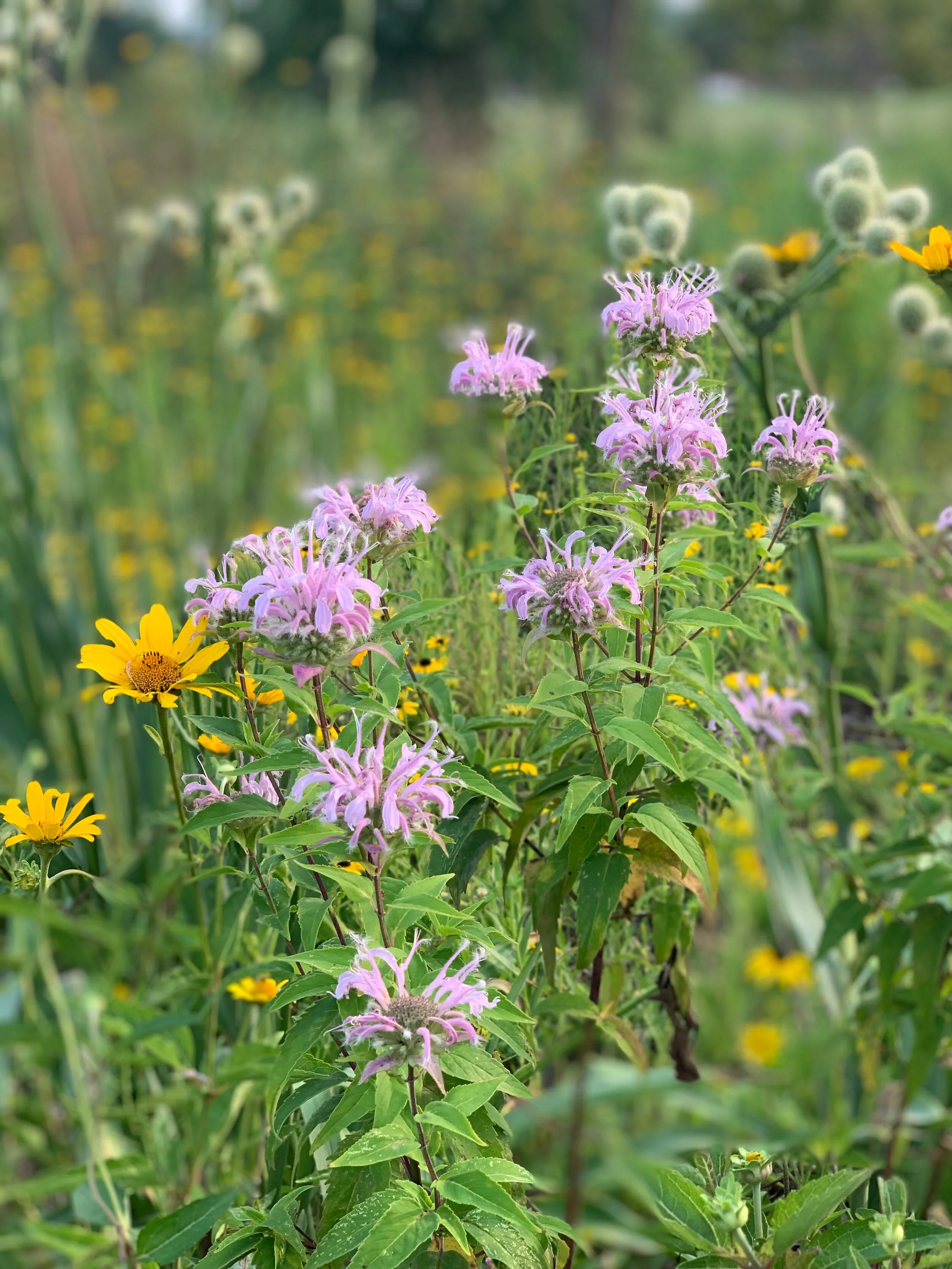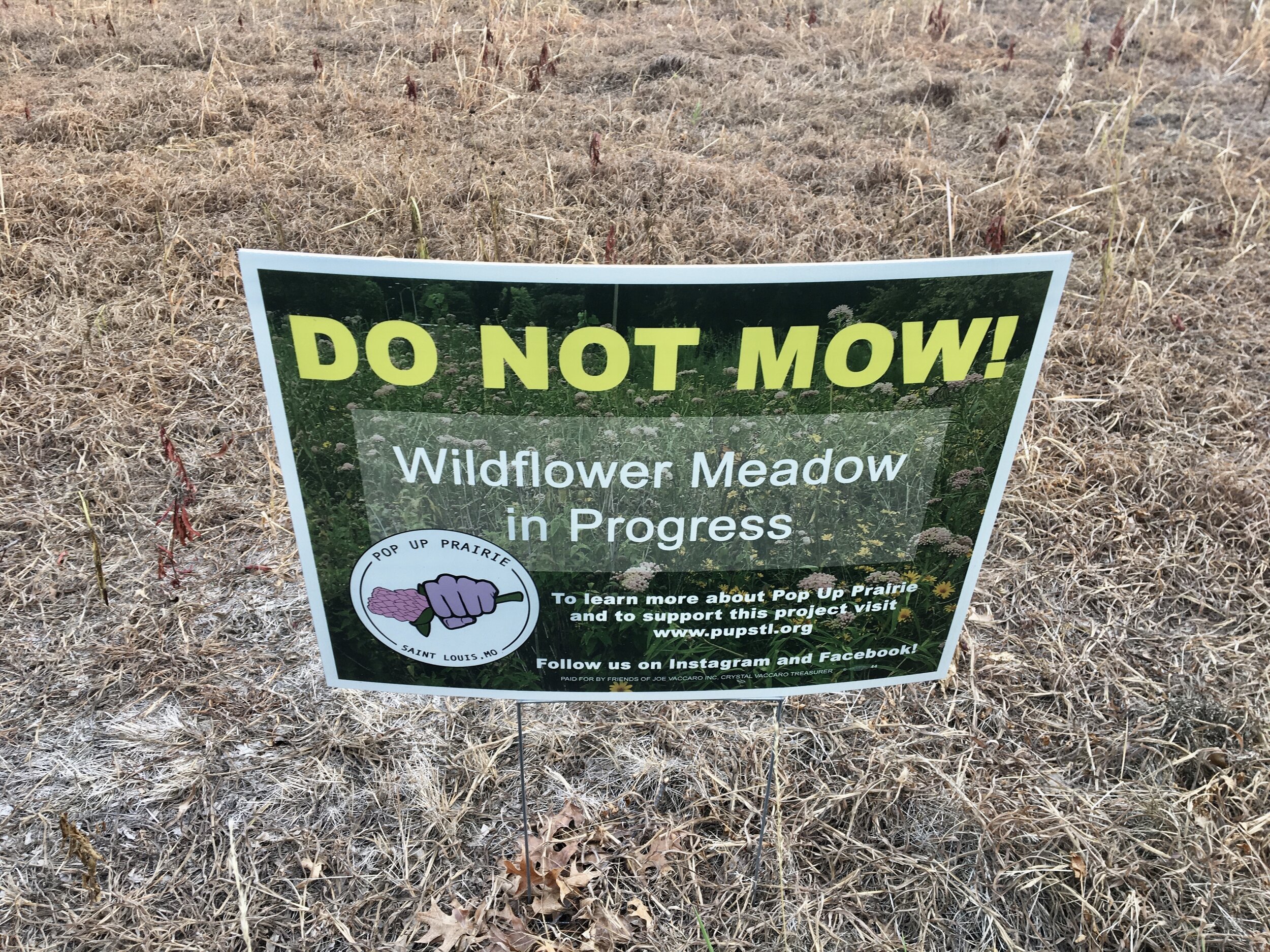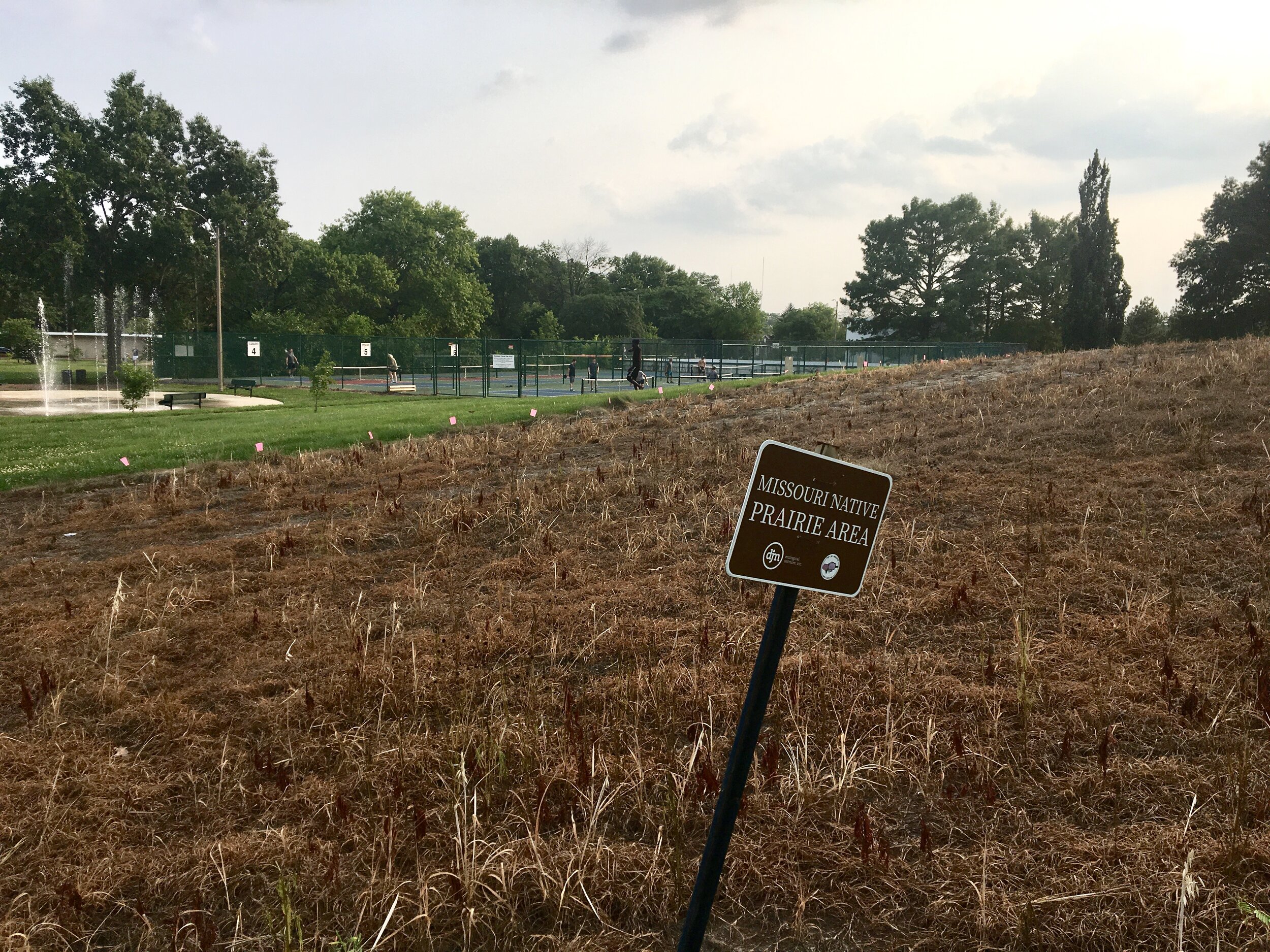Shannon and I have been taking frequent walks in Tilles Park on the western edge of the North Hampton Neighborhood. Our visits revealed an interesting discovery that required some investigation.
First, Tilles in general has been teeming with positive activity: full pickleball courts, a spray fountain in heavy use, playgrounds packed with kids, even people playing roller hockey. The basketball court was in full effect as was the workout equipment along the walking path. Even the bathrooms are open!
One night, we witnessed organized mountain bike racing taking place within the park.
This is our ideal for city living. A dense neighborhood and a functional park with diverse uses, people and ages. A place where people feel healthy, relaxed and comfortable.
But the real surprise came when we were walking toward a hillside just north of the baseball/soccer fields along Hampton Avenue, extending toward the tennis/pickleball courts. There were native plantings in full bloom and teeming with insect activity. Pollinators were everywhere. Surprisingly there were native bees and other Hemiptera. The European honey bees that most seek to attract were on the scene, but the diversity of insect species feeding on the various plants was stunning.
The sound was music to our ears. Typically our parks comprise acres of mowed grass/weeds with little to no species diversity and habitat for wildlife. But in this part of the park, pollinators and other insect and small mammal life was in full effect. The sounds of nature picked up near the established wildflower gardens.
We spent way more time here than we expected, observing the diverse amounts of insects and plants, some we’ve never before seen.
We then noticed a large swath of ground that appeared to be a burndown prepped for more prairie restoration.
Image source: Pop Up Prairie and Google Maps
After seeing a couple signs on the premises, we knew we had to learn more.
Per the sign, the organization working here was Pop Up Prairie (PUP). We reached out to the the PUP folks and in a few days, we were meeting with founder and executive director, Leigh Harris and co-founder & Urban Resources Manager Jeff Harris. Leigh and Jeff are a sister/brother duo from Springfield, IL. They visited St. Louis as children and fell in love with the city and chose to move here after graduating from Southern Illinois University - Carbondale. Leigh is a graphic designer with a Bachelor of Arts degree in visual communications, and Jeff has a Master’s Degree in forestry. Their talents matched up with their passion for prairie restoration, positive & diverse park uses and environmentalism, which led them to their inspiration that is PUP.
We met with Leigh, her husband Corey and Jeff this week in Tilles Park to see their work and learn a little more about the organization, their current work and future plans.
Left to right: Jeff Harris, Leigh Harris and Corey Gunnell (with little Pax in tow)
I’ve said it on this website many times, but the people of St. Louis are so kind and willing to meet & talk to strangers out of the blue. Intelligent, hard working, and most of all: caring people live among us. It’s people and projects like these that continue to make us optimistic about the future of this city.
The following is a summary of our conversation with Leigh, Jeff and Corey from Pop Up Prairies.
What is PUP?
“PUP is a 501(c)(3) nonprofit organization managing prairies in the city of St. Louis that provide critical habitat for monarch butterflies and other species of concern, clean the air we breathe and filter the water we drink.
Our mission is to establish and manage native prairie restorations in public spaces that serve as demonstration and education for the community. We set out to restore native habitat in urban spaces to bring balance back to the natural environment for the benefit of both animals and humans.
We are funded by grants, individual giving and fundraising events.”
Leigh and Jeff co-founded PUP in fall of 2015. Their first project was a pollinator garden at McDonald Park in the Tower Grove South Neighborhood.
How were these two parks chosen as sights for pollinator gardens and prairie restorations?
“According to the St. Louis University Billiken Bee Lab, we have more native bee diversity inside the city than anywhere on the North American continent. Even so, SLU research shows that bee populations and species diversity are lowest in South City in part due to the proliferation of well-manicured lawns that provide little to no functional habitat. PUP has restored over an acre of native prairie habitat in Tilles Park and McDonald Park to encourage native bee abundance and richness where it was recorded to be the lowest.
The alderman and Tilles Park Neighborhood association, along with the SLU Billiken Bee Lab were working together and asked us to take this project on.“
How do you engage with the neighborhood or city Parks Department to select a new project?
“PUP works very closely with the St. Louis City Parks Department, Ward Aldermen/Alderwomen, and neighborhood associations to select project sites. We target underutilized areas within the St. Louis City Parks. The planning has taken over a year, since these are the first types of installations the city has taken on, with the exception of Tower Grove and Forest Park which have foundations/associations working on their behalf.
It was exciting to be approached for a project of this size here in Tilles Park; we earned their trust in McDonald Park with a ~500 sq. ft, that grew to 1,000 sq. ft.”
What has the park-goer feedback been so far?
“Due to the fact that we manage our plantings, we have an opportunity to interact with park-goers on a daily basis. The feedback has been overwhelmingly positive and enthusiastic. Our prairie restorations have expanded the concept of park amenities past traditional turf grass, playgrounds and sports activities.”
Have you had any unexpected pushback?
“Attempts to restore prairie habitat in a public space often fail due to lack of follow up management. By prioritizing post installation management we have gained the trust of the community and are encouraged to expand where possible.”
The results are on display in both parks. This is a professional, skilled, well-executed and maintained space. The future is bright for Tilles Park, with an expansion of the prairie in the works.
“Thanks in part to a generous donation from The John E. McCarthy and Suzanne Langlois Foundation, the next prairie restoration project is underway. When completed it will span 43,560 square feet of previously mowed turf”
This site will be highly visible from Hampton Avenue and many places within the park.
A thorough evaluation of the park was conducted by PUP and the neighborhood stakeholders. Topographical maps and GPS helped inform the ideal locations to mitigate runoff, respect the existing park uses and maximize the carbon sinks with larger sites that are both under-utilized, yet accessible to park goers.
How are species and placement of plants selected and are they germinated from seed or placed as potted plants?
“We look at light, soil, and moisture requirements and that really helps to narrow down appropriate species for the site. Then, we look at the bloom period and what the plant will attract or host in terms of wildlife.
Smaller projects are plugged with potted plants and seed is broadcast across larger projects in the winter. The freeze-thaw cycle works the seed down through the thatch for good seed-to-soil contact.
Potted plantings are watered as necessary for the first couple of weeks and then are able to fend for themselves after that. Projects from seed will rely solely on mother nature for their moisture needs.
Contrary to what you may think, native plant communities such as a prairie do require on-going maintenance in the form of fire. Fire stops woody encroachment of trees and shrubs. Of course, land managers refer to this as a controlled burn because it is executed in a responsible manner. There are ways to simulate fire when you can’t burn. So far, in Tilles over 4,000 plants were installed in the first year. Native prickly pears were kept, but everything else is new.”
Have you noticed a difference in runoff, wildlife or self-propagation as the areas mature?
“We know that our projects are sequestering carbon and cleaning water runoff, but you can't ‘see’ that. But there are plenty of interesting phenomenon to be observed. Small, seemingly healthy ecosystems have returned to places on the landscape where they have not existed for decades upon decades. Within the ecosystem you can observe the food web from hawks at the top to layers of dragon flies, birds, bees, butterflies, and caterpillars at the bottom really driving those connections above.
Further, when you mow an acre of park land in a year’s time, you are putting close to a ton of carbon into the atmosphere from the mowers alone. These prairies can be huge carbon sinks, taking in ten tons of carbon, even after you offset the respiration and plant decay. These are really big carbon sinks and water purifiers.”
What are your future plans?
“It is true that we are facing a global extinction crisis today and that human actions have greatly contributed to it. We choose to invest our time countering that trend by restoring relict communities of Missouri prairie so that biodiversity is better represented in the future. Our projects provide a ‘natural’ climate solution for rising temperatures. Native prairie is a tremendous sink for carbon, or in other words prairie plants store carbon safely underground and indefinitely thus removing the primary trace gas from the atmosphere that traps heat.
Our goal is to have 10% of the park space across the city converted to prairies. And people are excited, they want to be part of this. The proof is here. People are craving the opportunity to be part of this and support has been high.
And believe it or not, the bigger the prairie, the easier it becomes to manage. Burn offs are labor intensive, so a larger space pays off for the prep and planning of an intensely managed, controlled burn. We designed the areas to have existing fire lines consisting of both natural breaks and hardscaped barriers. This fall the next areas on the hillsides will be drilled with seed. The seeds will germinate in spring, then are mowed to keep down weed competition and the natives can become established. In year two, they will be allowed to flush and year three you can start controlling with fire. Weeds succumb to the fire, and the natives are fire-evolved to out compete non-native weeds. The natives become aggressive following fire.”
Jeff’s graduate research was on the fire history of Southern Illinois hickory forests and he’s a “burn boss”. Meaning, the guy knows what he’s doing. He’s learned even more about the site after speaking to neighbors who have lived here for many years and can remember when animals grazed the land that is now Tilles Park. They are thrilled to see the park evolving.
“Our next park project will be in the North Riverfront Neighborhood. We are in the planning, community support and funding stages for a 20 acre project of shrub bottoms near the banks of the Mississippi River south of the Chain of Rocks bridge, near the Riverfront Trail. There are flooding challenges that don’t fare well with prairies; so instead we are planning buttonbush and other wetland shrubs to provide critical habitat for ducks on the flyway and sequester a lot of carbon and clean a lot of water.”
Our goal is to not just be good stewards at the installation, but also up and downwind or downstream of the projects. Our goal is to make this work well and benefit everyone involved.”
How can you help or get involved with PUP?
“Visit www.pupstl.org to learn more or make a donation. To date, the Missouri Department of Conservation, City of St. Louis Parks Department and Board of Public Services have been great collaborators and contributors. We are planning on getting local schools involved in student volunteer projects. People love to plant.”
Volunteer opportunities will be posted on the website and coming up October 2nd, PUP is organizing a community event and fundraiser at McDonald Park named Beers For Butterflies Music Festival. This event is, sponsored by Anheuser-Busch-InBev and co-hosted with Alpha Brewing Company and Civil Life Brewing Company. and hopefully other local businesses. It will offer a chance to meet the team, have a beer, listen to some local music and be part of the future. The plan is to be at McDonald Park noon to sundown, with local food trucks and plenty of other fun.
Seeing is believing. Go check out the spaces in McDonald and Tilles for yourself and spend some time in one spot to observe just how many different animals are crawling and flying around. Listen to the sounds of nature. Some plants are going to seed, some are in full bloom and others are still in a growth phase. The system appears to be working.
This generation of St. Louisans understand the necessity of better managed spaces for a healthier future. Necessity is driving this as carbon levels have risen to their highest levels in recorded history. But take stock in the fact that there are people among us who are devoted to the work behind the much needed change.
Cheers to PUP and thanks for trusting us with your story and helping spread the good word. Now get on down to McDonald Park October 2nd to toast them and wish them the best for future projects.










